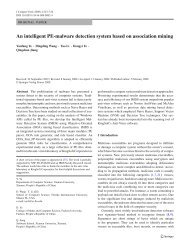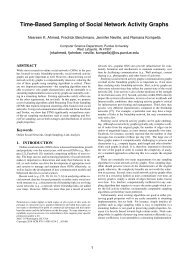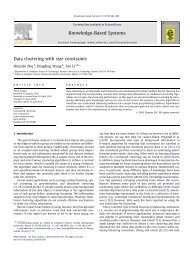IMDS: Intelligent Malware Detection System - Florida International ...
IMDS: Intelligent Malware Detection System - Florida International ...
IMDS: Intelligent Malware Detection System - Florida International ...
You also want an ePaper? Increase the reach of your titles
YUMPU automatically turns print PDFs into web optimized ePapers that Google loves.
Industrial and Government Track Short Paper<br />
share a common core signature. Schultz et al. [13] applied Naive<br />
Bayes method to detect previously unknown malicious code. Decision<br />
Tree was studied in [18, 9]. Kolter et al. [9] gathered 1971<br />
benign executables and 1651 malicious executables in Windows<br />
PE format, and examined the performance of different classifiers<br />
such as Naive Bayes, support vector machine (SVM) and Decision<br />
Tree using 10-fold cross validation and plotting ROC curves [16].<br />
Their results also showed that the ROC curve of the Decision Tree<br />
method dominated all others.<br />
Different from earlier studies, our work is based on a large collection<br />
of malicious executables collected at KingSoft Anti-Virus<br />
Laboratory. In addition, we apply OOA mining technique to extract<br />
the characterizing frequent patterns to achieve accurate malware<br />
detection since frequent patterns found by association mining<br />
carry the underlying semantics of the data.<br />
third party binary compress toll, it needs to be decompressed before<br />
being passed to the PE parser. Through the API query database,<br />
the API execution sequence generated by the PE parser can be converted<br />
to a group of 32-bit global IDs which represents the static<br />
execution sequence of the corresponding API functions. Then we<br />
use the API calls as the signatures of the PE files and store them in<br />
the signature database, which contains 6 fields: record ID, PE file<br />
name, file type (“0” represents benign file while “1” is for malicious<br />
file), called API sequence name, called API ID, and the total<br />
number of called API functions, as shown in Figure 2. After that,<br />
an OOA mining algorithm is applied to generate class association<br />
rules which are recorded in the rule database. To finally determine<br />
whether a PE file is malicious or not, we pass the selected API calls<br />
together with the rules generated to the malware detection module<br />
to perform the association rule based classification.<br />
3. THE SYSTEM ARCHITECTURE<br />
Our <strong>IMDS</strong> system is performed directly on Windows PE code.<br />
PE is designed as a common file format for all flavors of Windows<br />
operating system, and PE viruses are in the majority of the viruses<br />
rising in recent years. Some famous viruses such as CIH, CodeRed,<br />
CodeBlue, Nimda, Sircam, Killonce, Sobig, and LoveGate all aim<br />
at PE files. The system consists of three major components: PE<br />
parser, OOA rule generator, and malware detection module, as illustrated<br />
in Figure 1.<br />
Figure 2: Samples in the signature database<br />
Figure 1: <strong>IMDS</strong> system architecture<br />
The functionality of the PE parser is to generate the Windows<br />
API execution sequence for each benign/malicious executable. Since<br />
a virus scanner is usually a speed sensitive application, in order to<br />
improve the system performance, we developed a PE parser to construct<br />
the API execution sequences of PE files instead of using a<br />
third party disassembler. If a PE file is previously compressed by a<br />
4. CLASSIFICATION BASED ON OOA<br />
MINING<br />
Both classification and association mining play important roles<br />
in data mining techniques. Classification is “the task of learning a<br />
target function that maps each feature set to one of the predefined<br />
class labels” [17]. For association rule mining, there is no predetermined<br />
target. Given a set of transactions in the database, all<br />
the rules that satisfied the support and confidence thresholds will<br />
be discovered [1]. As a matter of fact, classification and association<br />
rule mining can be integrated to association rule based classification<br />
[10, 2]. This technique utilizes the properties of frequent<br />
patterns to solve the scalability and overfitting issues in classification<br />
and achieves excellent accuracy [2]. In our <strong>IMDS</strong> system, we<br />
adapted OOA mining techniques [14] to generate the rules.<br />
4.1 OOA Definitions<br />
In our <strong>IMDS</strong> system, the goal is to find out how a set of API calls<br />
supports the specific objectives: Obj 1 = (Group = Malicious),<br />
and Obj 2 = (Group = Benign).<br />
• Definition 1 (Support and confidence) Let I = {I 1, ..., I m}<br />
be an itemset and I → Obj(os%, oc%) be an association<br />
rule in OOA mining. The support and confidence of the rule<br />
are defined as:<br />
count(I ∪ {Obj}, DB)<br />
os% = supp(I, Obj) = × 100%<br />
|DB|<br />
oc% = conf(I, Obj) =<br />
count(I ∪ {Obj}, DB)<br />
count(I, DB)<br />
× 100%<br />
1044









